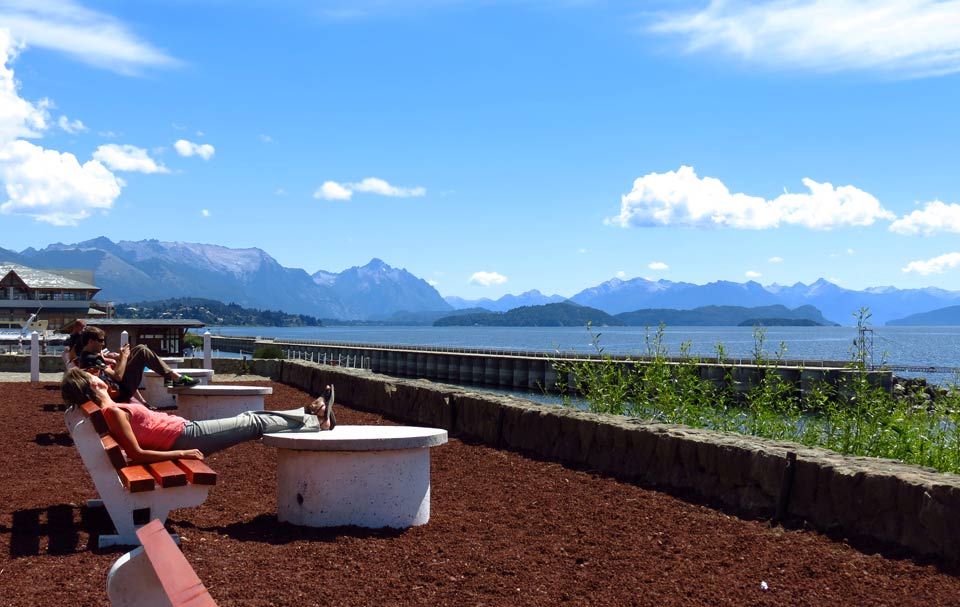On the south shore of the Nahuel Huapi Lake, within the Nahuel Huapi National Park, at 41º South Latitude and 770 metres above sea level, is located San Carlos de Bariloche. Being one of the most important tourist resorts in Argentina, this beautiful mountain village has become the entrance gate to Argentine Patagonia.
The urban zone has a unique landscape diversity that varies from the imposing scenery of the Andes and its rainforest, to the characteristic steppe-like vegetation in a short range of a few kilometers, thanks to its location in the transition zone between the pre-cordillera and the steppe.
With a wide variety of services based on an important infrastructure of all-category hotels, Bariloche offers the widest range of options for conventional and adventure tourism with around 800.000 tourists visiting it every year, as well as a very important pole of scientific and technological development on a national and international level, which has lead to the city being home to the most important tourist centre in Patagonia.
Weather
This area has continental cold climate with a dry season. The temperatures and rainfall are unevenly spread in the National Park area, varying from west to east, between the Chilean border and the Limay River.
The temperature lowers abruptly from the foot of the mountains towards the summit. These variations in climate, plus differences in soil, relieves and geomorphology, results in important changes in the vegetation and fauna.
There are few places in the world where the seasons are so well marked as in Bariloche.
In summer, the days are warm and sunny, with cool nights, scarce rains and prevailing winds from the Southwest. The days are long; there is sunlight until 10:00 pm. The average temperature is 18º C, with maximums of 27 and minimums of 9.
In autumn, the days are fresh-tempered with cold nights. Temperature varies between 4 and 13 centigrade degrees. Autumn is a rainy season, but is not unusual that the wind blows from the East with cold and dry weather. Spectacular shades of gold, rust and brown can be seen during the fall.
In winter, days are colder with snowfalls; the average temperature is 2 centigrade degrees, oscillating between -10 and 8 C°.
In spring, days are cool and getting longer. The temperature increases gradually, slowly diminishing the volume of rainfall. The nights are cold, maintaining the coolness during the day; temperatures vary between 7 and 20 degrees towards the end of the season.
Nahuel Huapi National Park
Nahuel Huapi National Park, which comes from the Mapuche language, Nahuel meaning ‘tiger’ and Huapi meaning ‘island’, is an extended natural area protected under special regulations regarding conservation and protection.
Its remarkable scenic beauty dazzled early explorers and inhabitants, many of them European immigrants, who found the area very similar to their homeland and made it their permanent place of residence.
The Park is located in SW Neuquen and NW Rio Negro in an area of 710.000 hectares (1.754.386 acres).
Within the Nahuel Huapi National Park, there is Los Arrayanes National Park, covering an area of 1793 ha that includes the whole of the Quetrihue peninsula in the northern coast of Nahuel Huapi Lake. Very well known for the Arrayanes Forest (Myrceugenella), trees of singular beauty, with their smooth cinnamon-colored bark and twisted trunks.
One of the most significant features in the area are the lakes and large rivers, which flow either into the Atlantic or the Pacific Ocean, fed by the great amount of rainfalls and melted snow from the mountains.The main and largest one is the Nahuel Huapi Lake with 600.000 ha. Large peninsulas such as LLao-LLao, San Pedro and Huemul; and abruptly cut off arms of still unknown depths such as Rincon, Tristeza, Blest, Ultima Esperanza and Angostura outline its irregular shoreline.
Regarding the flora and fauna, the National Park houses a large amount of protected species.
There are different biomes (a large community of plants and animals that occupies a distinct region) represented in the park: Andean-Patagonian Forest, Lake, steppe and High Mountain environments.
In the rivers, lakes and streams we can find a number of various fish species including the natives: perca, puyen and the Patagonian pejerrey; and some introduced species such as rainbow trout, brown and brook trout and salmon.
In the Andean-Patagonian forest, we can find a large number of native tree species such as: Coihue, Maiten and Radal; and, in more marshy areas: Arrayan and Patagua.
If you are lucky enough, maybe you can see some autochthonous mammals such as the Pudú-Pudú or midget deer, the Hhuemul (deer), the Puma and the Huillín or river otter, the Red Fox, the Zorrilla, the midget weasel etc., these are scarce and can rarely be seen. Amongst the exotic fauna we have the Red Deer, and herds of Guanacos that can be watched on the slopes of Valle Encantado.
The avifauna is represented by the Cormorant, Cauquen, Bandurria, Gull, the Woodpecker, the Great Bustard, etc. The large common Grebe or Huala, the Bandurria, the Bustard and the gullible Chucao, can be easily spotted. You can also listen to the sad whistle of the Fio-Fio. The birds of prey are abundant on the steppe; and the best known, the majestic Condor, is on high summits. Who had not tremble at watching the magnificence of its flight…?





